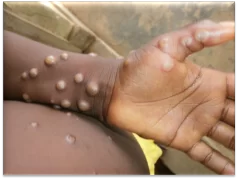Table of Contents
Viral hemorrhagic fevers are infectious diseases capable of causing severe and life-threatening illness. They have the potential to harm the walls of small blood vessels, leading to leakage and impairing the blood’s clotting ability.


While the resulting internal bleeding is typically not immediately life-threatening, these diseases themselves pose significant risks.

Join our Telegram Channel for Updates
These diseases are most prevalent in tropical regions, and in the United States, individuals who contract them often have a recent travel history to these areas.
Examples of hemorrhagic fevers
– Dengue
– Ebola
– Lassa
– Marburg
– Yellow fever
Symptoms
The signs and symptoms of viral hemorrhagic fevers vary depending on the specific disease. In general, early indications may include:
– Fever
– Fatigue, weakness, or an overall sense of feeling unwell
– Dizziness
– Muscle, bone, or joint aches
– Nausea and vomiting
– Diarrhea
More severe symptoms that can pose life-threatening risks include:
– Bleeding under the skin, in internal organs, or from the mouth, eyes, or ears
– Malfunctions in the nervous system
– Coma
– Delirium
– Kidney failure
– Respiratory failure
– Liver failure
Causes
These fevers are transmitted through contact with infected animals or insects. The viruses responsible for these fevers inhabit various animal and insect hosts, with mosquitoes, ticks, rodents, or bats being the most common carriers.
Certain viral hemorrhagic fevers can also be transmitted from person to person.
Transmission Methods
– Some viral hemorrhagic fevers are spread through mosquito or tick bites.
– Others are transmitted through contact with infected body fluids, such as blood, saliva, or semen.
– A few variants can be contracted through inhalation of infected rat feces or urine.
In cases where a specific hemorrhagic fever is prevalent in an area you visit, infection may occur there, but symptoms may not manifest until after returning home. The incubation period varies depending on the virus, ranging from two to 21 days before symptoms appear.
Prevention
Risks of hemorrhagic fevers present challenges. If you reside in, work in, or travel to regions where these diseases are prevalent, safeguard yourself against infection by employing appropriate protective measures when handling blood or bodily fluids.
This includes the use of protective gear such as gloves, eye protection, and face shields. Additionally, exercise caution in the handling, disinfection, and disposal of laboratory specimens and waste.
Vaccination is a key preventive measure
– The yellow fever vaccine is generally considered safe and effective. However, rare instances of serious side effects may occur. It is not recommended for children under 9 months, pregnant women (especially during the first trimester), or individuals with compromised immune systems.
– An Ebola vaccine is available, offering protection against a specific type of Ebola. Check with the Centers for Disease Control and Prevention for vaccination requirements in the countries you plan to visit, as some nations may mandate certificates of vaccination for entry.
Take measures to avoid mosquitoes and ticks
– Wear light-colored, long pants and long-sleeved shirts, or opt for clothing treated with permethrin, avoiding direct skin application.
– Steer clear of outdoor activities, if possible, during peak mosquito activity at dusk and dawn. Apply mosquito repellent containing 20% to 25% DEET on both skin and clothing. Use bed nets and mosquito coils in tented camps or hotels.
Prevent rodent exposure
– In areas prone to viral hemorrhagic fever outbreaks, take precautions to keep rodents out of your home.
– Store pet food in rodent-proof containers and cover it securely.
– Use rodent-resistant containers for trash and clean them regularly.
– Dispose of garbage consistently.
– Ensure doors and windows have tight-fitting screens.
– Maintain a distance of at least 100 feet between your house and woodpiles, stacks of bricks, or other materials.
– Trim grass and brush within 100 feet of your house.









